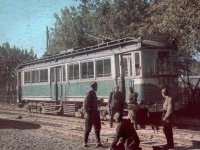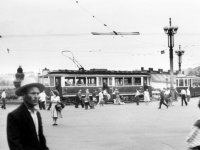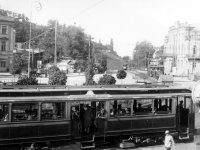| 1003 |  | 1003, the first serial Pullman in Kiev, at the Nuremberg plant, waiting to be delivered.
[Kiev Electric Transportation Museum, 1907] |
|
| 1008 |  | A car on route 4, which ran from the downtown area to the
Cable Factory back then. The photo spot is the corner of today's Melnikova
and Yakira; the photographer stands near the house which is now Melnikova, 22,
and looks south; in the background is the present-day Melnikova, 75.
[USSR Photo Archive, Krasnogorsk, 1930] |
|
| 1021 |  | At the corner of Vladimirskaya and Yaroslavov Val.
The Pullman proceeds towards Sofievskaya Ploschad along route 1,
which at the time ran from Ploschad Tolstogo, and meets an MTV-82
on route 2, which is about to turn right into Yaroslavov Val
and go to the railway station via Lvovskaya Ploschad.
[Aare Olander collection, 1950's] |
|
| 1023 |  | A unique shot by a German war correspondent
captured a powerless car on Bulvar Shevchenko, in the block between
Ploschad Pobedy and Vozduhoflotsky Most (nowadays this is a part
of Prospekt Pobedy). The photo was first published in
a book Babi Yar: People, Power, History, vol. 1,
Kiev, 2004 (in Russian).
[Johannes Hähle, 01.10.1941] |
|
| 1023 |  | The same car eighteen years later.
The "push-pulls", rebuilt from the Pullmans, will look very similarly.
This car, however, has not been renamed or renumbered.
The spot, the northern Kontraktovaya Pl. terminus, looks almost the same today.
[Raymond De Groote, Jr., 12.07.1959] |
      |
| 1024 |  | At the Paton Bridge, with a lonely Pobeda car.
No long comments are necessary. Those who care remember well
why the tram line was destroyed here and what was the result...
[State Photo Archive of Ukraine, 12.1954] |
|
| 1026 |  | At the Vokzal (railway station) loop,
between a Kh+M train and an MTV-82 car.
Trolleybuses do run here today, but trams don't since 1996.
[J. Slezak, 14.08.1958] |
  |
| 1028 |  | On route 28, two years after it first crossed
the Paton bridge. The street is all but empty, the new houses
of the late-Stalin era are awaiting their inhabitants...
Quite recently they got rid of the tram line here as well.
[State Photo Archive of Ukraine, 08.1956] |
|
| 1029 |  | The terminus of route 1, which ran along
Kreschatik at the time. In the background one sees the European Hotel
building, the square's present-day namesake, the Vladimir Hill,
the building of the philharmonic society — and more Pullmans.
Our car carries an ideologically sound inscription, right where the
route table is supposed to be:
"Workers' socialist competition workers is a guarantee of the practical
fulfillment of the decisions of the 16th [Communist] party conference".
[USSR Photo Archive, Krasnogorsk, 1929] |
|